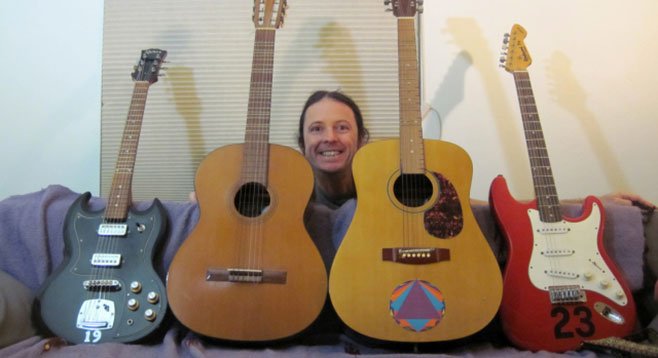 Facebook
Facebook
 X
X
 Instagram
Instagram
 TikTok
TikTok
 Youtube
Youtube

“The San Diego Experimental Guitar Show started out as an event that included all of my noise-artist friends,” says host Sam Lopez in anticipation of the event’s fifth annual incarnation at the Soda Bar on Saturday, March 29. “I later added artists who weren’t necessarily noise musicians. These are artists who incorporate music into their art.”
Illustrative of this shift is the headbanging performance by visual artist Vabianna Santos and composer Clint McCallum, in which their motions are translated into sound via the thrashing of hair upon droning guitars.
SDSU professor David Lipson, meanwhile, takes what he’s learned from his career as a microbiologist and applies it to the design of microtonal guitars that deviate from the standard 12-note system.
“I removed the frets from various electric and acoustic guitars and repositioned them to create new scales,” says Lipson, who will be performing on his modified instruments. “My creative urge to do science and experimental music probably both stem from the same part of my personality. Biology and music both present fun puzzles...and can produce beautiful surprises that emerge from either collecting data or tinkering with weird tuning systems.”
Lipson says his music is inspired by math and science. He describes his compositions as “completely inaccessible, audience-hostile experimental geek music with no commercial potential.”
Also performing will be T. Putnam Hill (who runs his guitar through analog filters and oscillators to create electro-acoustic sound collages), Santino Romeri (of live beats outfit Illuminauts and Kill Quanti records), and Glen Galloway (no-wave garage frontman from Octa#grape).
“With this, and really any of my events, I’m never sure what to expect,” says Lopez, who throws a Stay Strange installment monthly. “I think that’s the real essence of the show. Each artist is picked for their ability to add a dimension to the event. Yet, the idea that their performance may lay outside of their comfort zone is appealing as well. I think this is when we see our most unique presentations.”


“The San Diego Experimental Guitar Show started out as an event that included all of my noise-artist friends,” says host Sam Lopez in anticipation of the event’s fifth annual incarnation at the Soda Bar on Saturday, March 29. “I later added artists who weren’t necessarily noise musicians. These are artists who incorporate music into their art.”
Illustrative of this shift is the headbanging performance by visual artist Vabianna Santos and composer Clint McCallum, in which their motions are translated into sound via the thrashing of hair upon droning guitars.
SDSU professor David Lipson, meanwhile, takes what he’s learned from his career as a microbiologist and applies it to the design of microtonal guitars that deviate from the standard 12-note system.
“I removed the frets from various electric and acoustic guitars and repositioned them to create new scales,” says Lipson, who will be performing on his modified instruments. “My creative urge to do science and experimental music probably both stem from the same part of my personality. Biology and music both present fun puzzles...and can produce beautiful surprises that emerge from either collecting data or tinkering with weird tuning systems.”
Lipson says his music is inspired by math and science. He describes his compositions as “completely inaccessible, audience-hostile experimental geek music with no commercial potential.”
Also performing will be T. Putnam Hill (who runs his guitar through analog filters and oscillators to create electro-acoustic sound collages), Santino Romeri (of live beats outfit Illuminauts and Kill Quanti records), and Glen Galloway (no-wave garage frontman from Octa#grape).
“With this, and really any of my events, I’m never sure what to expect,” says Lopez, who throws a Stay Strange installment monthly. “I think that’s the real essence of the show. Each artist is picked for their ability to add a dimension to the event. Yet, the idea that their performance may lay outside of their comfort zone is appealing as well. I think this is when we see our most unique presentations.”
Comments